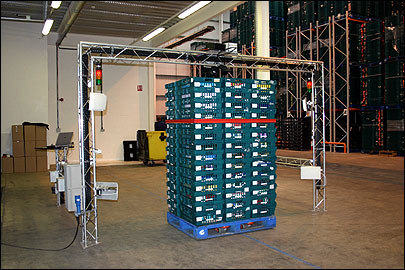U.K. RFID systems integrator Intellident has announced one of its first trial customers for the UHF RFID portal system developed by a consortium of RFID vendors led by the company.
As part of an initial RFID pilot set to start in December, Dutch wholesale groceries and services supermarket group Schuitema, which operates 80 of the more than 400 C100 supermarkets in the Netherlands, will deploy one portal at one of its distribution centers and another at the receiving dock in the back of one of its stores. A fresh vegetable supplier, Heemskerk, will tag reusable trays shipped to the retailer’s DC. Those shipments will be tracked when they arrive and leave the DC, and when they arrive at the receiving dock of the RFID-enabled C1000 store. Dutch telecom operator KPM will manage the data processing and networking capabilities of the trial.

Schuitema and KPM—as well as Cap Gemini, which served primarily as a pre-project consultant—first announced their plans in May to work on an RFID trial this year. According to Intellident, Schuitema had performed some in-house tests using RFID in the past, but this is its first trial to track assets shipped by a supplier to one of the retailer’s DCs, and then on to a store.
Once underway, the planned system will share RFID data between Schuitema and its supplier. “The project will demonstrate real-time EPC data collection, processing and transfer, and represents the first EPC-based initiative for the consortium,” says Andy Chadbourne, marketing and communications manager at Intellident, based in Stockport. The initial trial will track fresh produce (mainly vegetables) for three months. Schuitema’s goal for the trial is prove that EPC Gen 2 technology is robust across its supply chain, Chadbourne explains.
The consortium, formed in 2004 by Intellident, Philips Semiconductors, UPM Rafsec and Feig Electronic, launched its portal concept in July (see Intellident Debuts UHF RFID Portals). The group has designed two portals, one specifically for use in the retail supply chain, the other for the automotive supply chain. The system uses readers (interrogators) and reader antennas from Feig, designed to work specifically with UPM Rafsec RFID labels made with Philips chips (Philips Ucode EPC 1.19) and Rafsec tag antennas. It also uses Intellident’s Vision software to control and process data written to and collected from RFID tags and smart labels.
Startup systems integrator RFIQ Solutions carried out the testing and configuration of the portal, and worked with Intellident to test and develop it. Their goal is to be able to offer preconfigured portals for specific industry uses, thereby reducing the requirement for companies to spend time and resources tuning portals for their own deployments.
Given the relatively small amount of radio frequency spectrum available for European UHF RFID use, and the requirement that each reader not transmit until it determines if other local readers are already using that spectrum, RFIQ maintains that it is crucial for the consortium’s portals to work reliably when other readers are nearby.
“Our objective is to make a portal that can be deployed many times over in close proximity, with a minimum of installation and maintenance,” says Simon Howell, RFIQ’s managing director. Intellident and RFIQ have been working at the consortium’s RFID lab, located at a reusable container DC run by Intellident’s parent company, Linpac Group, just outside Crewe, in northern England.
The lab is geared toward developing an integrated RFID portal that can be preconfigured to work in a number of environments and with a range of tagged shipments—even those with products containing a high percentage of water or metal. Water absorbs RF signals and metal reflects them, so it was important for the lab to take those factors into account when designing the system.
According to Howell, developing a portal that can be used widely across the retail sector means establishing how each portal component performs with the others.
“It’s important to not take one part of a system—like a reader or a tag—and try to get it to work, but to look at the whole portal holistically. We absolutely have to look at each bit and know how each component works, and then ultimately replicate the portal [use the same portal configuration for multiple deployments and customers] to get that to work not only in an environment [that our customer] controls but also in other DCs with portals that [our customer] won’t have control over”
This summer, more than 50 representatives of U.K. companies visited the lab to see demonstrations of the consortium’s portal and learn how RFID operates and can be used in their operations. Another 40 are scheduled to visit later this month. Part of the demonstration shows tagged pallets and trays as they move through the portal, with each tagged tray identified and its contents listed.
According to Intellident, two other customers are also testing the consortium’s retail portal, but those trials have not been made public.

